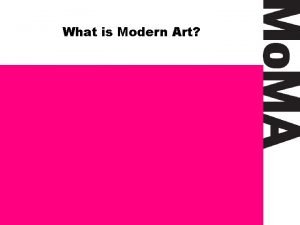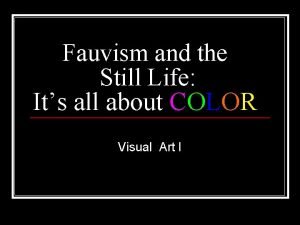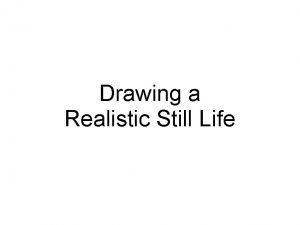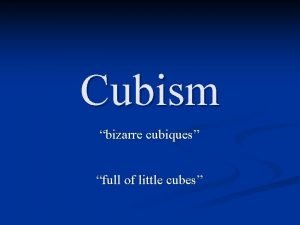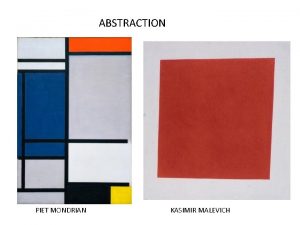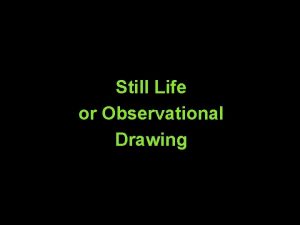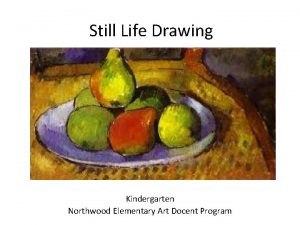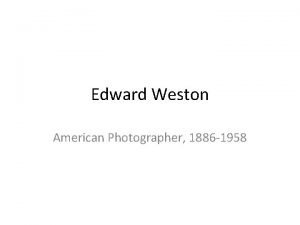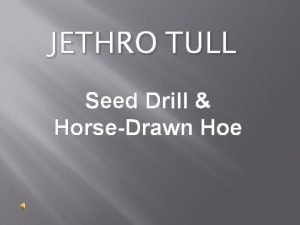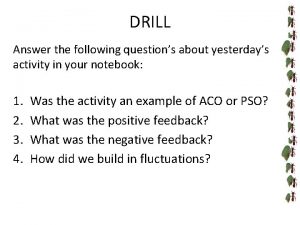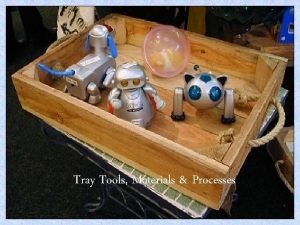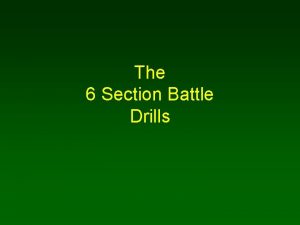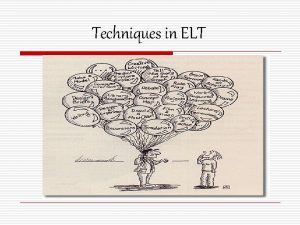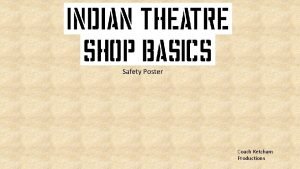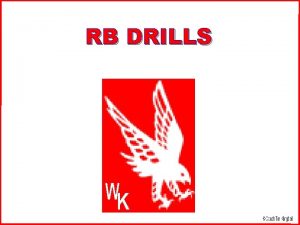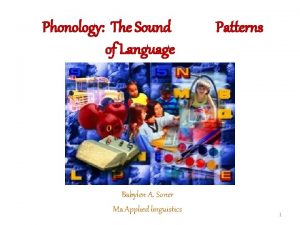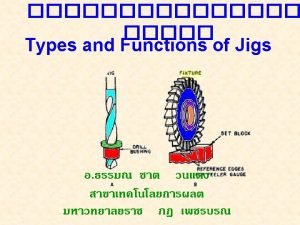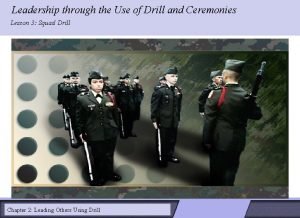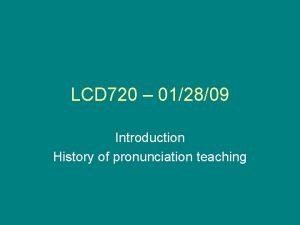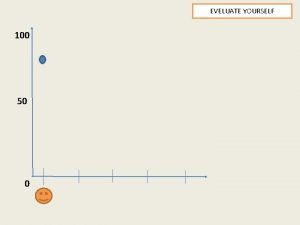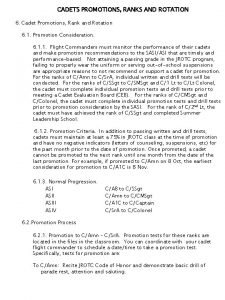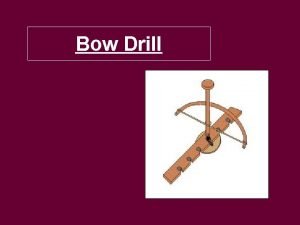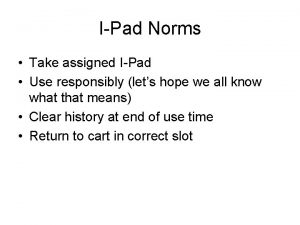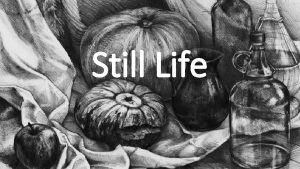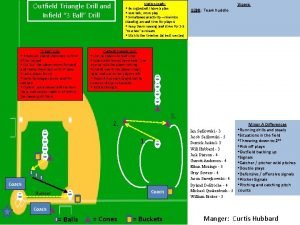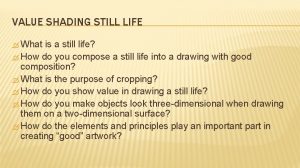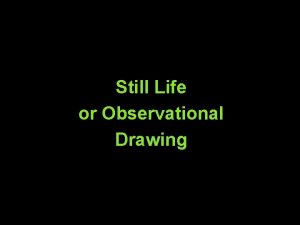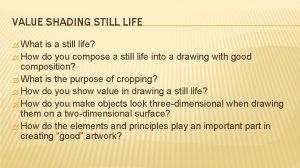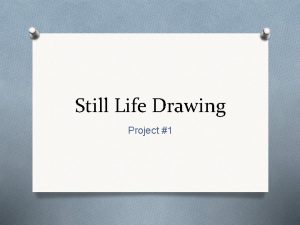Still life STILL LIFE DRILL GET AND IPAD


![What is a still life? • A still life (plural still lifes [1]) • What is a still life? • A still life (plural still lifes [1]) •](https://slidetodoc.com/presentation_image_h/b889b3d7a806e79514524245a94028ce/image-3.jpg)



































































- Slides: 70

Still life

STILL LIFE DRILL: GET AND IPAD; TAKE OUT YOUR OBJECTS. Objective: You will learn arrangement techniques in order to make an effective still life composition. If you want to get objects now- you will need 6+. LOOK UP ANSWERS ON POWER POINT. 1. 2. 3. 4. 5. 6. 7. WHAT IS A STILL LIFE? Where did it originate? What is ‘nature morte’? What is vanitas? List some symbolism: What makes a good still life? What make a bad still life? What does overlapping do to an artwork?
![What is a still life A still life plural still lifes 1 What is a still life? • A still life (plural still lifes [1]) •](https://slidetodoc.com/presentation_image_h/b889b3d7a806e79514524245a94028ce/image-3.jpg)
What is a still life? • A still life (plural still lifes [1]) • is a work of art depicting mostly inanimate subject matter, typically commonplace objects which may be either natural (food, flowers, plants, rocks, or shells) or man-made (drinking glasses, books, vases, jewelry, coins, and so on) in an artificial setting. • still life or still- life – • A picture of inanimate objects. • Common still life subjects • include vessels, food, flowers, books, clothing. • Animate means • that which lives or moves, as opposed to inanimate, that which doesn't live or move.

Still Life Origin • What is a still life? The name still life comes from the Dutch stilleven - meaning inanimate objects - the morbid French name is nature morte. • Nature morte- Dead nature (French) • ‘Stilleven’- Dutch.

Adam Bernaert

Kevin Best


Vanitas Still life • Vanitas is a type of symbolic work of art especially associated with still life painting in Flanders and the Netherlands in the 16 th and 17 th centuries. • The Latin word means "vanity" and loosely translated corresponds to the meaninglessness of earthly life and the transient nature of all earthly goods and pursuits.

VANITAS • The Dutch "vanitas" (Latin for vanity) still life brings together the prevailing moral tone and an appreciation of everyday objects: how vain and insignificant are human concerns, and, therefore, how important it is to turn to God. • The term comes from the biblical Book of Ecclesiastes (1: 2) "Vanity of vanities! All is vanity. " These objects symbolize transitory human achievement and satisfactions

Vanitas Symbolism • Skull: Death, this is a clear memento mori message or the transience of life, a universally recognized symbol of death. • Watch or hourglass: time is limited and is passing, therefore, use it wisely. See a typical one-handle XVII century watch at the lower right of the photo. • Books: Human knowledge and its temporary nature. • Artist’s instruments e. g. Palette, brushes, easel: Indulgence in the arts, very few could afford to be painters let alone patronize the arts. • Shell: they were normally exotic ones not commonly available in the Netherlands. They were a symbol of the vanity that comes with wealth, as these were exotic items at the time, only a very wealthy person would have one of those.

• Sea shells, sometimes living snail, a mollusc shell is the remains of once-living animal, it means death and frailty. Creeping is the personification of death Sin snail laziness. Large shellfish represent the duality of nature, symbol of lust, even one of the deadly sins. • Fuming candle or oil lamp is a symbol of the human soul, its loss symbolizes the care. • Cups, playing cards or dice, chess (rarely) is a sign of faulty life goal, finding pleasures and sinful life. Equality of opportunity in gambling meant also the reprehensible anonymity. Cigar tube — a symbol of transient and elusive of earthly delights. • Mirrors, glass balls — a symbol of vanity, mirror, reflection, shadow sign too.

Good vs. Bad Still Life Objective: You will learn arrangement techniques in order to make an effective still life composition. Drill: 1. What makes a good still life? 2. What makes a bad still life? 3. What does overlapping do to an artwork?

What makes the set up of a still life successful?

LIST 2 REASONS WHY YOU LIKE OR DON’T LIKE EACH: A. B.

Make it look natural.

• Have a variety of heights.

Overlap- Place in front of each other:

• Overlap objects. • Put one in front of the other. • Creates depth.

• Groups objects. • Groups of 3 or 2. • Pull one object so that it is separated.

Zoom In

Make it interesting- flip a cup over.

What makes a good/ bad still life? • Bad- evenly spaced, symmetrical, not touching, plain, boring, same size, stacked object sculpture, everything face the same way. • Good- Overlapping, in groups, touching, asymmetrical, off the paper, different heights, variety of objects, a theme, natural looking, opposite diagonals.

1. Draw Contour lines first

2. Use ellipses for cylindrical forms

2. Make sure standing objects have parallel vertical lines:

3. Use your pencil to get the angles.

4. Remember to actually LOOK at your objects!

Putting it together:

What makes a good composition? HOW TO AVOID BORING COMPOSITIONS: • Large size of objects • Change the view so it is not just from the side… change the angle… • Change the placement so that it is not in the middle. - to the side… • Line the objects up so they overlap or are stacked… make sure they are not evenly spread and boring.

Objects~ • Forms under clock • Bottles cans- front desk • Gargoyles skulls- on filing cabinets • Other goodies- under flag • Please be very careful getting supplies and putting them back. • Return them to appropriate box.

Today’s Class: Set up your own still life. Place it on white paper. Minimum of 6 objects. Good- Overlapping, in groups, touching, asymmetrical, off the paper, different heights. • Choose some challenging objects- bottles, sculptures, toys. • All will be shaded in pencil, one object with colored pencil. Save one to add color. • • • Get white paper once you have a good still life set up. Start your drawing. 12 x 9 minimum.

Take a picture or your still life: • Save it to your Edmodo backpack. • This way you can set it back up next class. • Please be very careful getting supplies and putting them back. • Return them to appropriate box.

STILL LIFE 1. MAKE A GOOD STILL LIFE. • Good- Overlapping, in groups, touching, asymmetrical, off the paper, different heights. 2. Set up your own 7 objects. You can use more than 7. 3. Set them up on a white piece of paper or fabric. 4. 3 of the objects should be simple forms. 5. Sketch it out quickly in your sketchbook and/ or take a photo.

Harmen Steenwyck

Adriaen van Utrecht

Adam Bernaert

Kevin Best

Kevin Best







Vanitas Symbolism • Skull: Death, this is a clear memento mori message or the transience of life, a universally recognized symbol of death. • Watch or hourglass: time is limited and is passing, therefore, use it wisely. See a typical one-handle XVII century watch at the lower right of the photo. • Books: Human knowledge and its temporary nature. • Artist’s instruments e. g. Palette, brushes, easel: Indulgence in the arts, very few could afford to be painters let alone patronize the arts. • Shell: they were normally exotic ones not commonly available in the Netherlands. They were a symbol of the vanity that comes with wealth, as these were exotic items at the time, only a very wealthy person would have one of those.

Vanitas Symbolism • Insects, decaying flowers: transience of life. They were inserted in paintings depicting expensive objects as a reminder that life is temporary and moral considerations deserved more attention than material things. • Broken or tipped over glassware: transience of life or life is fleeting. • Musical instruments: indulgence of the senses as a luxury. Sometimes they are present as artistic inspiration, as music would inspire artists. • Silk or velvet tablecloths: vanity, as these were expensive things. Silk being the ultimate fabric material and purple the most expensive dye, hence the Roman emperors wore purple tunics.

Vanitas Symbolism • Oriental rugs or carpets: These were prohibitively expensive items, carpets were placed on tables to avoid stepping on them and causing decay in their colors or integrity. They were a symbol of wealth but also a sign of pride as they were items brought into the United Provinces through trade and commerce. • Jewelry, clothes or mirrors: remember the temporary nature of beauty, wealth and wisdom. Earthly riches are temporary and therefore life should be carried out according to the modesty traditions that were in place at the time. • Mirror: a clear symbol of the vanity that should be avoided. • Jars: Stoneware or porcelain were used for water or oil, both substance sustain life at the time.

• The skull is a reminder of the inevitability of death. Just as the portrait is only a reflection of once-living person and the skull is only the form of once-living head. The spectator must perceive it as “flipping”, it most clearly symbolizes the frailty of human life. • Rotten fruit is a symbol of aging. Mature fruits symbolize fertility, abundance, in the figurative sense of wealth and well-being. A number of fruit has its value: fall of man is denoted by pears, tomatoes, citrus fruit, grapes, peaches and cherries, and of course Apple. Erotic undertones are figs, plums, cherries, apples or peaches. • Flowers (fading); Rose is the flower of Venus, symbol of love and sex, that vain, as is inherent. Poppy is a depressant that produces opium, the character of mortal sin of laziness. Tulip is a collectible in the Netherlands of the 17 th century, the symbol of the folly, irresponsible and unreasonable treatment bestowed by God.

• Sea shells, sometimes living snail, a mollusc shell is the remains of once-living animal, it means death and frailty. Creeping is the personification of death Sin snail laziness. Large shellfish represent the duality of nature, symbol of lust, even one of the deadly sins. • Fuming candle or oil lamp is a symbol of the human soul, its loss symbolizes the care. • Cups, playing cards or dice, chess (rarely) is a sign of faulty life goal, finding pleasures and sinful life. Equality of opportunity in gambling meant also the reprehensible anonymity. Cigar tube — a symbol of transient and elusive of earthly delights. • Mirrors, glass balls — a symbol of vanity, mirror, reflection, shadow sign too.

• Musical instruments, music page – brevity and the ephemeral nature of life, a symbol of art. • Books & maps (mappa mundi), the pen is the symbol of Sciences Pentium. • The globe – is the Earth and sky. • Palette with brushes, a laurel wreath (usually on a skull), is painting and poetry. Portraits of beautiful women, anatomical drawings. Vanitas • Coin purses, jewelry boxes, jewelry and cosmetics are designed to create beauty, feminine appeal, while at the same time they are linked with the vanity, narcissism and the mortal sin of arrogance. They also signal of their owners’ absense.

• Lemons (in earlier times) was a very expensive food item, and a popular item used, especially peeled with its attractive play of lights on translucent flesh, yet they are so sour and bitter, and in this symbolizes the deceptive allure or attraction of earthly beauty. • Artichokes, asparagus and strawberries were, for their part, symbolic of the fruits of Paradise or Heaven. Flowers have long been included as a still life subject. Different flowers hold different meanings. They can symbolize innocence, the four seasons, or religious symbols. The rose for instance, stands for love, the lily for purity, and the sunflower for devotion. Birds, or a pair of birds represent the resurrection of the soul after death. The bee, as well as the butterfly, are symbols of hope, and because they are rather delicate, are a reminder to the fragility of life. The mouse, being a very fertile animal, became a symbol of lechery and destruction. Ivy, as an evergreen symbolizes eternal life. The peach symbolizes truth and salvation, and is used as a replacement to the maligned apple Feathers symbolize the virtues of hope, faith, and charity (in religious works), and they represent freedom (by enabling flight) and the heavens.

• Shells, in a religious work, represent pilgrimages, or saints. The clam symbolize the Virgin Mary. In contemporary works, they symbolize sensuality and the pleasures of the flesh. Skulls or bones, when in the painting, symbolize mortality. The skull also represent inner contemplation, and eternity. • Books: learning or of transmitting knowledge. The Lute (a really old version of a guitar) with broken strings: Death or discord. The candle, it’s a big one and has lots of meanings. It can indicate the passing of time, faith in God (when its burning). When extinguished, it means death, or the loss of virginity, and the corruption of matter. It can symbolize light in the darkness of a lonely individual, or the light of Christ, purification or cleansing. The clock: the passing of time. Mirror: stands for truth or vanity. By showing an image of a subject that reflect what others see. This self awareness allows fruitful introspection and the viewers attempt to find the truth, or lead to simple vanity.

• The apple: Another big one in that there are many meanings. It can signify love, knowledge, wisdom, joy, and death. In religious works it usually means temptation, and original sin. The apple is also associated with a woman’s anatomy, breasts in particular, and then the core of the halved apple representing her sexuality or reproductive parts. The sword also a common item in earlier works, but not used much in contemporary art. It symbolizes power, protection, authority, strength, courage. It is phallic, (with the sheath representing the female reproductive parts) and many paintings with soldiers, swords and women in the painting had the sexual overtones within their meaning. Artists during the renaissance era also used things like monkeys, parrots and other birds, and cats. The parrot, the birds, and the cat – like the monkey – personify specifically human failings. The monkey represents chaos. They also symbolize man entrapped by earthly and sensual desires. When the monkey is depicted holding an apple, it represented the fall of man. The Cat: usually meant illicit love. Medieval times the cat represented lust and prostitutes (now you know where the term “cat house” comes from). But in later paintings, it is included to help provide a peaceful and enjoyable companion with which they are depicted. For centuries cats are considered mysterious, beautiful, and exotic.







Think about having a theme.

Objects from home!!!!

• From home. Accessories, food, candy, shells, statues, etc…

Watch image slide show of previous years’ still life pics.

STILL LIFE 1. MAKE A GOOD STILL LIFE. • Good- Overlapping, in groups, touching, asymmetrical, off the paper, different heights. 2. Set up your own 7 objects. You can use more than 7. 3. Set them up on a white piece of paper or fabric. 4. 3 of the objects should be simple forms. 5. Sketch it out quickly in your sketchbook and/ or take a photo.

Common Sense Rules for the classroom when doing still life: • (Probably cover boxes of objects so that other classes aren’t tempted to touch them. ) • Store your objects in a bag that is labeled with your name on it. • Remember which box or exact location that you got your objects. • PUT THEM BACK IN THE EXACT SAME SPOT – PEOPLE ARE SHARING • Be respectful of the objects. Don’t dent the cans or pull of the flowers. Carry them carefully so you don’t drop them.

Still Life RACE: 1. 2. 3. 4. 5. 6. 7. Work with the person next to you. You will have 5 minutes to get objects. Get a minimum of 5 objects. Get forms from up front, too. Set up your bad still life first. Then draw it. Change it to make it a good still life.

Timer: 5 minutes 1. You will have 5 minutes to set up a good still life and a bad still life using the qualities listed from previous slide. 2. Get 5+ objects. 3. 5 objects for the bad still life 4. 5 objects for the good still life

Time is up! 1. Set up bad still life first, then draw it in BAD STILL LIFE box. 2. How can you change it to make it a good still life? 3. Set up a good still life and sketch it in GOOD STILL LIFE box.

What makes a good/ bad still life? MAKE A SKETCH OF EACH: • Bad- evenly spaced, symmetrical, not touching, plain, boring, same size, stacked sculpture • Good- Overlapping, in groups, touching, asymmetrical, off the paper, different heights, variety of objects, a theme, natural looking, OBJECTS TOUCHING THE SIDES OF THE PAPER.

STILL LIFE 1. MAKE A GOOD STILL LIFE. • Good- Overlapping, in groups, touching, asymmetrical, off the paper, different heights. 2. Set up your own 7 objects. You can use more than 7. 3. Set them up on a white piece of paper 4. Objects can be should be simple forms. 5. Sketch it out quickly in your sketchbook and/ or take a photo for memory of set up.
 Sirh minsal
Sirh minsal Get on get off get into get out of
Get on get off get into get out of One direction shot me out of the sky
One direction shot me out of the sky Aarp app for ipad
Aarp app for ipad Menstruation during pregnancy symptoms
Menstruation during pregnancy symptoms Get up get moving quiz
Get up get moving quiz Get up get moving quiz
Get up get moving quiz Get up get moving quiz
Get up get moving quiz Selection pseudocode
Selection pseudocode Get focused get results
Get focused get results Germer
Germer Dead nature drawing
Dead nature drawing Pablo picasso mandolin
Pablo picasso mandolin Cezanne still life
Cezanne still life Still life questions
Still life questions Maddie lambert
Maddie lambert Fauvism colour wheel
Fauvism colour wheel Realistic still life drawing
Realistic still life drawing Still life vocabulary
Still life vocabulary Picasso’s still life with chair caning
Picasso’s still life with chair caning Analytical cubism
Analytical cubism Still light tunic описание на русском
Still light tunic описание на русском Contour still life
Contour still life Simple pumpkin still life
Simple pumpkin still life Still life observational drawing
Still life observational drawing Mixed media still life
Mixed media still life Still life research
Still life research Still life with compotier art movement
Still life with compotier art movement Elementary still life drawing
Elementary still life drawing Still life photography
Still life photography Still life plural
Still life plural Kategori foto jurnalistik
Kategori foto jurnalistik Va 21-8951
Va 21-8951 Seed drill jethro tull
Seed drill jethro tull Harap sa kanan
Harap sa kanan Cutting speed drilling
Cutting speed drilling Question and answer drill
Question and answer drill Hammer drill symbol
Hammer drill symbol Clamp and drill hydraulic circuit
Clamp and drill hydraulic circuit Roll up and drill down in data warehouse
Roll up and drill down in data warehouse Football strip drills
Football strip drills Drill and ceremony commands
Drill and ceremony commands Counter column march army
Counter column march army What is multimodal text
What is multimodal text Veterinary suffixes
Veterinary suffixes Pillar seed drill
Pillar seed drill 6 section battle drills uk
6 section battle drills uk Multiple slot substitution drill
Multiple slot substitution drill Section battle drills
Section battle drills Drill press safety poster
Drill press safety poster Star drill agility
Star drill agility Juncture examples
Juncture examples Leaf jigs
Leaf jigs Basketball 22's conditioning
Basketball 22's conditioning Spot drill depth calculator
Spot drill depth calculator Machine tools mcq
Machine tools mcq Drill
Drill Color 012809
Color 012809 Immediate action drill
Immediate action drill Basic fire fighting training ppt
Basic fire fighting training ppt Exercices de drill
Exercices de drill Phonetic drill
Phonetic drill Code grey hospital
Code grey hospital How are drill presses measured
How are drill presses measured Within the right angle drill the defender wraps
Within the right angle drill the defender wraps Drill across
Drill across 30 step drill sequence
30 step drill sequence Howstuffworks
Howstuffworks The lip clearance angle is the angle formed by the *
The lip clearance angle is the angle formed by the * Backward build up drill
Backward build up drill Drill team officer binder
Drill team officer binder













